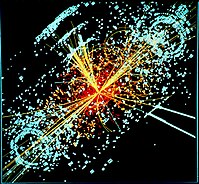
Photo from wikipedia
A bstractThe cold dark matter fermions with mass MeV scale, pair produced inside the supernova SN1987A core, can freely stream away from the supernovae and hence contributes to its energy… Click to show full abstract
A bstractThe cold dark matter fermions with mass MeV scale, pair produced inside the supernova SN1987A core, can freely stream away from the supernovae and hence contributes to its energy loss rate. Similar type of DM fermions (having similar kind of coupling to the standard model photon), produced from some other sources earlier, could have contributed to the relic density of the Universe. Working in a theory with an effective dark matter-photon coupling (inversely proportional to the scale Λ) in the formalism of Tsallis statistics, we find the dark matter contribution to the relic density and obtain a upper bound on Λ using the experimental bound on the relic density for cold non-baryonic matter i.e. Ωh2 = 0.1186 ± 0.0020. The upper bound obtained from the relic density is shown with the lower bound obtained from the Raffelt’s criterion on the emissibity rate of the supernovae SN1987A energy loss ε⋅e+e−→χχ¯≤1019$$ \overset{\cdot }{\varepsilon}\left({e}^{+}{e}^{-}\to \chi \overline{\chi}\right)\le {10}^{19} $$ erg g−1s−1 and the optical depth criteria on the free streaming of the dark matter fermion (produced inside the supernovae core). As the deformation parameter q changes from 1.0 (undeformed scenario) to 1.1 (deformed scenario), the relic density bound on Λ is found to vary from ∼ 4.9 × 107 TeV to 1.6 × 108 TeV for a fermion dark matter (χ) of mass mχ = 30 MeV, which is almost10 times more than the lower bound obtained from the SN1987A energy loss rate and the optical depth criteria.
Journal Title: Journal of High Energy Physics
Year Published: 2018
Link to full text (if available)
Share on Social Media: Sign Up to like & get
recommendations!